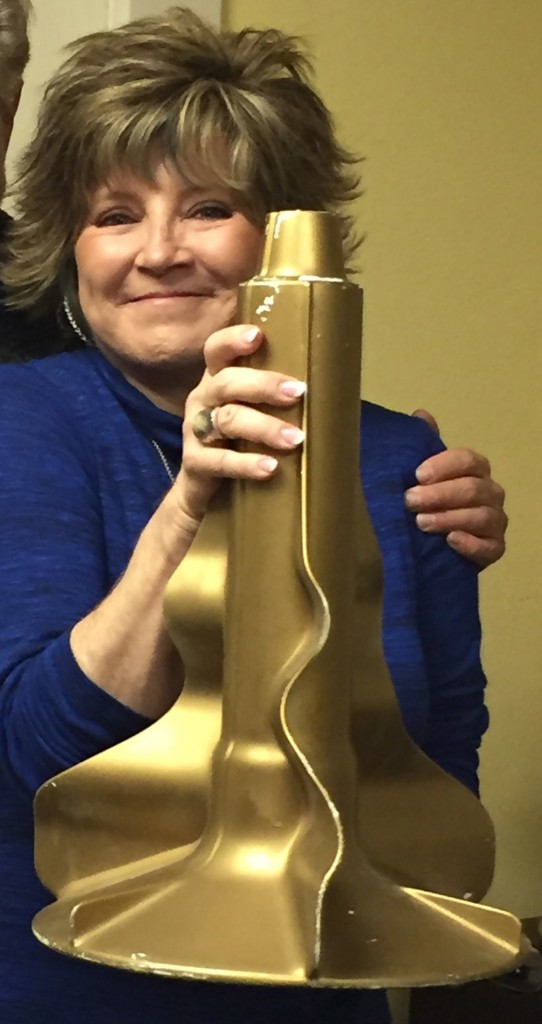EPA Rejects Texas’ BS and Submits Its Own Air Plan for Parks. Will It Do the Same For People?
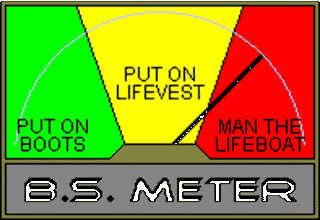 As you might have already heard, last week the EPA announced it was rejecting Texas' proposed rapid-response,140-year plan for restoring air quality and visibility in National Parks affected by pollution from the state's largest industrial facilities, primarily coal-fired power plants, aka, "the haze rule."
As you might have already heard, last week the EPA announced it was rejecting Texas' proposed rapid-response,140-year plan for restoring air quality and visibility in National Parks affected by pollution from the state's largest industrial facilities, primarily coal-fired power plants, aka, "the haze rule."
Instead, the EPA decided to implement its own, slightly more decisive plan for action. Whereas the state concluded it needed no new controls on any coal plants, the EPA is requiring modern Sulfur Dioxide (SOx) scrubbers on 14 different boilers at nine power plant sites across the state it estimates will remove 230,000 tons of the pollutant annually. That's 60% of the state's total SOX pollution, and 7% of the nation's.
These scrubbers not only capture SOx on behalf of more beautiful vistas in Big Bend, they also do a good job of preventing lots of Particulate Matter pollution from reaching the lungs of people that live in between the coal plants and parks. Although computer modeling was used by EPA to determine the effectiveness of the scrubbers it's requiring, it focused on results inside the parks. Getting results for metro areas like DFW involves a lot of data mining nobody has done, but there's no question that if reductions in air pollution are helping Oklahoma and West Texas parks, they're also helping out the air in North Texas. Just one look at the modeling maps produced by our recent UNT study of DFW ozone shows the immense impacts of these plants on DFW air quality.
For residents of DFW, the reductions in pollution are overdue and welcome news (the process leading up to this rule can be traced all the way back to 1977), and it certainly makes it even less likely that the big bad old TXU plants (Big Brown, Monticello and Martin Lake) can escape their obsolescence after bankruptcy proceedings.
But the way the EPA determined to go it alone in this case may be much more important to DFW's own air quality in the long run as the actual reductions it implements.
Not to put too fine a point on it, but EPA called BS on the way Texas was obscuring the data needed to write a good haze rule plan. This M.O. sounds awfully familiar to citizens watching the way the State has drafted its anti-smog plan for DFW, now officially approved by the TCEQ Commissioners and on its way to a public hearing in Arlington on Thursday, January 21st (6 pm, HQ of North Central Texas Council of Governments, 616 Six Flags Road).
And if EPA is willing to stand-up to Texas over air quality in parks, shouldn't it take at least as strong a stand on behalf of seven million souls in DFW?
About the same time EPA was announcing a federal takeover of the haze rule plan, Downwinders released its new video appealing for help from the EPA to reject the State's do-nothing smog plan for DFW. A big part of our case is its reliance on faulty analysis and downplaying or obscuring evidence that contradicts the state's ideological position that no new pollution controls for smog are needed in a region in its third decade of continual violation of the Clean Air Act and after a summer where smog averages increased…twice.
Which makes the language EPA uses to justify this takeover of the haze rule plan all the more relevant, and gives residents some hope should the Agency apply the same logic to the State's pathetic response to DFW's chronic smog problem.
EPA accuses Texas of hiding the most effective control strategies from EPA and Oklahoma (where the Wichita Mountains Wildlife Refuge is affected by Texas-based pollution seven times as much as Oklahoma-based SOx) by flooding its emissions inventory data with both large and small sources of SOx from across the state, washing out the impact of the larger coal plants.
"During the interstate consultation required by the Regional Haze Rule, Oklahoma and Texas discussed the significant contribution of sources in Texas to visibility impairment at the Wichita Mountains, but Texas concluded that no additional controls were warranted for its sources during the first planning period to ensure reasonable progress at the Wichita Mountains, or at its own Class I areas, the Big Bend and the Guadalupe Mountains National Parks.
In reaching this conclusion, Texas relied on an analysis that obscured the benefits of potentially cost-effective controls on those sources or groups of sources with the largest visibility impacts in these Class I areas by inclusion of those controls with little visibility benefit, but which served to increase the total cost figures.
This flawed analysis deprived Oklahoma of the information it needed to properly assess the reasonableness of controls on Texas sources during the consultation process and prevented Texas from properly assessing the reasonableness of controls to remedy visibility at Big Bend and the Guadalupe Mountains.
A few pages later EPA reiterates the charge,
Texas’ analysis was deficient and not approvable because the large control set it selected was not appropriately refined, targeted, or focused on those sources having the most significant and potentially cost-effective visibility benefits. We conclude this control set included controls on sources that would increase total cost figures, but would achieve very little visibility benefit…because Texas only estimated the visibility benefit of all the controls together, it was not able to assess the potential benefit of controlling those sources with the greatest visibility impacts, and potentially cost-effective controls. Therefore, the effects of those controls with the greatest visibility benefits were obscured by the inclusion of those controls with little visibility benefit. This only served to increase the total cost figure, making Texas’ potential control set seem less attractive.
In analyzing whether additional controls should be required for some of its sources under the long-term strategy provisions of the Regional Haze Rule, Texas relied on the same flawed analysis discussed above that it relied on to evaluate additional controls under the reasonable progress provisions to address visibility impairment at Texas’ own Class I areas. Texas’ analytical approach obscured the contributions of individual sources that Texas’ own analysis indicated could be cost-effectively controlled.
This deprived Oklahoma of the information it needed to properly assess whether there were reasonable controls for Texas sources and to properly establish reasonable progress goals for the Wichita Mountains that included the resulting emission reductions.
That's just about as plain an outline of a state government conspiracy to avoid complying with the Clean Air Act as the EPA puts in print. And it sets the stage to examine the State's DFW air plan using the same fine-toothed comb for rooting-out analytical crap meant to obscure inconvenient facts on the ground.
For example, the State's conclusion that no new controls for smog are warranted is based on an analysis of what's "reasonably available" that's every bit as flawed as anything dreamed up by Austin for dodging its responsibilities to national parks. It ignores modern controls already operating on cement kilns, gas compressors, and coal plants – to the point of not even mentioning the permitting of these controls by the TCEQ itself.
Moreover, hard as it is to believe, the state's conclusion on smog controls is based on no modeling of the impact of those controls on air quality. That was left up to Downwinders and its UNT study, using the state's own computer modeling. What that effort provided was nothing less than a road map for how to get the most cost-effective cuts in smog by reducing pollution from those kilns, coal plants, and compressors. This is information the state could have gotten if it wanted it, but it didn't want it because it disputed the ideological position that no new pollution controls for industry are justified. It knew if it looked, it would have to release the results. So it just didn't look.
Finally, the state is still claiming that its plan will get DFW "close enough," to the 75 ppb standard, clocking-in at 77.8 ppb. So the plan doesn't even accomplish its goal. That makes it completely indistinguishable from the last five state air plans for DFW. What the State is counting on is EPA giving them credit for a wish list collection of unquantifiable stuff under the regulatory category of "Weight of Evidence." This is exactly the same strategy used in past plans. Ride new changes in federal law as far as you can and convince the EPA that "trends" are in your favor to make up any slack.
Only this time, "trends" may be working against the State. The summer of 2015 saw an increase in regional smog averages, indicating that perhaps its do-nothing approach isn't working. If you combine this information with the fact that smog levels also rose during the last do-noting plan from 2011, you have some "trends" crying out for an EPA takeover.
Since the TCEQ has approved its DFW air plan for submittal to EPA, we won't have to wait long to find out what the Agency's response will be. Public comments are due by January 29th. Let's hope EPA's review of an air plan for people's health in the nation's fourth largest metropolitan area is as rigorous as it was for the one looking out for visitors to the Wichita Mountains.
Tamera Bounds: Our Agitator of the Year
"agitator"
noun
ag·i·ta·tor \ˈa-jə-ˌtā-tər\
Definition of agitator
• a person who urges others to protest or rebel.
• a device for stirring or shaking something.
For a long time now, Downwinders has used its end-of-the-year gatherings to recognize special accomplishments among is board members. One of these recognitions is almost as old as the 21-year old group itself, our "Agitator of the Year" award.
Originally created to take back ownership of a word used so pejoratively by our opponents, the exercise has succeeded in becoming an annual institution of sorts, symbolized by the awarding of an actual "bronzed" washing machine agitator. In giving the honor, we explain that just like the actual thing itself, an agitator must shake and stir up things. They must often shake and stir more to get the really deeply-embedded dirt out. And even when things don't come out 100% shiny, they're always better having been put through the wash.
In 2015, we had no better role model for effective agitation than Tamera Bounds, a new board member from Mansfield, where she's been deeply involved in that city's battle over gas drilling rules for the last three years.
Tamera's Mansfield Gas Well Awareness group took the fight over more protective practices right to the middle of the Gas Patch. While she came up short on getting as much as she wanted, she managed to put the fear of God into the industry, who mounted the largest post-Denton campaign to shut her down, and completely overhauled an obsolete city-drilling ordinance. She and her group of concerned residents forced the last big fight over urban fracking before the passage of HB40.
Not content with that result, Tamera then decided to run for Mansfield City Council in the Spring, directy taking on the town's good ol' boy power structure and running in a town where all the seats are still "at-large" (the Voting Rights Act not having discovered Mansfield on a map yet). Again, she came up short, but advanced her cause among fellow residents and frightened the bejeepers out of the Gas industry.
On the Downwinders board, she became an early advocate of the grassroots conference that would become our Root and Branch Revue. She took responsibility for organizing the first look at a post-HB40 strategy for fracking activists, as well as a the full day of workshops in our "University of Change." These would not have gone as well as they did, or happened at all, without her leadership.
Along with some other key "new-wave" fracking activists, she's now trying to do what should have been done a decade ago and establish a regional alliance of citizen groups who can work together across city limits.
Oh yeah, she does all this while being the president of her homeowners association and performing her full time job as a health care professional who practically offices out of her car.
She's shown herself to be a non-nonsense hard worker whose energy is now indispensable to our Board. She's set a very high bar of productivity that even full-time professional organizers would be hard-pressed to match. She exemplifies the kind of activist who not only tries to win her own battle, but seeks to contribute to the larger fight as well.
That's why Downwinders at Risk's 2015 Agitator of the Year goes to Tamera Bounds with much appreciation and affection. Thanks Tamera, and to all our agitating board members who give their time and energy to shake and stir things up so that they – and you – won' have to breathe air that will make them sick or kill them.
“Help Us. We Live in Texas.”
(Dallas)— “Help Us: We Live in Texas.”
That’s the plea of a video released today by a local clean air group claiming the state has so intentionally sabotaged Dallas-Fort Worth anti-smog efforts that residents now need EPA to take over the job.
“Texas is as likely to enforce the Clean Air Act in 2015 as Mississippi was to enforce the Voting Rights Act in 1965,” said Downwinders at Risk’s Director Jim Schermbeck, echoing a line in the video.
The group posted the 2:42 minute piece, titled “SOS @EPA” in response to this morning's vote by the Texas Commission on Environmental Quality (TCEQ) to move forward with a new anti-smog plan for DFW that the Commission has already been told by EPA falls short of legal and regulatory requirements.
In the video, footage from a Downwinders’ street action calling for help at EPA Regional Headquarters in downtown Dallas November 5th is spliced with facts about DFW’s 20 years and counting chronic smog problem. Central to the group’s charge is the state’s unwillingness to put new controls on major sources of industrial air pollution like the Midlothian cement kilns, East Texas coal plants, and gas facilities – despite the fact their own air modeling shows those controls could bring smog down enough to comply with the Clean Air Act.
Today’s vote by the TCEQ is the second in 12 months concerning the same DFW air plan. Its goal is to get from an average of 83 parts per billion (ppb) of smog in 2015 down to the current federal standard of 75 ppb by 2017.
However, the state only estimates a best-case result of almost 78 ppb. Despite that shortfall, there are no new pollution controls required of any major sources. Over the last 20 years, the state has written five anti-smog plans for DFW. None has accomplished its goal on deadline, and regional smog levels actually rose this year.
Besides once again failing to hit is mark overall, the EPA has already told the State its formal assessment of modern pollution controls for those major sources needed revisiting to be legal. TCEQ refused to comply with EPA and today’s plan contains exactly the same assessment as the one EPA has already said isn’t sufficient, making that part of the plan instantly illegal. Although EPA gives state governments authorization to write smog plans for their own metropolitan areas, it still has final approval based on criteria listed in the Clean Air Act.
One of the points made in the group’s video is that studies by local hospitals have shown DFW childhood asthma rates to be as much as four times the state average and over twice the national average, making the need for cleaner air imperative.
“The health of seven million Dallas-Fort Worth residents is being held hostage by a state government hostile to the goal of clean air. Only federal intervention can save us,” said Schermbeck.
The video can be found at Downwinders at Risk’s website (downwindersatrisk.org), it’s Facebook page, twitter account (@cleaner air) and the group’s YouTube channel (Downwinders’ TV).
__________________________________
SEND EPA ADMINISTRATORS A MESSAGE TO REJECT THE STATE'S PLAN AND WRITE ONE OF ITS OWN:
https://www.downwindersatrisk.org/featured-citizen-action/
AND
SIGN THE CHANGE.ORG PETITION:
https://www.change.org/p/ron-curry-and-gina-mccarthy-environmental-protection-agency-reject-texas-smog-plan-for-dallas-ft-worth
________________________________________
LIKE THIS VIDEO? LIKE OUR WORK? THINK IT'S IMPORTANT?
THEN PLEASE MAKE A TAX-DEDUCTABLE CONTRIBUTION TO DOWNWINDERS BEFORE DECEMBER 31st.
DONATE HERE.
________________________________________
WHY?
It might be hard to believe, but despite being the nation’s fourth largest metropolitan area, AND being in constant violation of the Clean Air Act for smog since 1991, AND having higher annual smog numbers than Houston, AND being singled out by EPA as one of only a handful of areas expecting to STILL be in violation of the Clean Air Act in 2025, there’s still only one professional staff person devoted to cleaning up DFW air: the staff person you pay for when you contribute to Downwinders at Risk.
Besides community organizing on the ground, Downwinders also had to go out and build a new committee of local officials concerned about dirty air after the traditional regional air quality planning process broke down. That committee produced a first-ever study showing how new pollution controls on the kilns, coal plants, and compressors could bring smog levels down enough to comply with the Clean Air Act. Our study was used by the Dallas Commissioners Court to pass a resolution requesting new controls on the East Texas coal plants in October. Had it not been for our new committee, there would have been no local officials involved in the DFW air quality planning process at all, and noaccountability for a state government that isn’t interested in our lungs.
Want to get just basic information about DFW air pollution? There are no dedicated environmental beat reporters left in DFW. Downwinders fills this gap as well, providing the only source of reliable and timely information on DFW air quality issues.
Need technical or organizing training? We do that too. Many of you know we just sponsored our first conference – the four-day Root and Branch Revue, featuring a graduating class of 70 grassroots activists from our first “University of Change.”
When you give to Downwinders, you fund the last line of defense between your lungs and a state government that doesn’t believe smog is that bad for you.
And when you give to Downwinders, you know you’re giving to a group with a two decade proven track record of getting results.
That’s our pitch. We get your donation. You get our best effort at protecting your lungs.
On behalf of myself, and the Downwinders at Risk board, thank you for your consideration.

Jim Schermbeck
Director, Downwinders at Risk
Peak Shale? More Energy from Renewables Than Gas by 2020
 In late November, a new report by Goldman Sachs came out predicitng “New wind turbines and solar panels worldwide will provide more energy over the next five years than U.S. shale-oil production has over the past five."
In late November, a new report by Goldman Sachs came out predicitng “New wind turbines and solar panels worldwide will provide more energy over the next five years than U.S. shale-oil production has over the past five."
“The leading renewable-energy technologies will add the equivalent of 6.2 million barrels of oil a day to the global energy mix, exceeding the 5.7 million barrels a day pumped from U.S. shale oil wells since 2010 …" According to the study, "the biggest shift will occur over the next decade as demand for renewable energy, LED lighting and plug-in vehicles accelerates.”
“Wind and solar are on track to exceed 100 gigawatts in new installations for the first time,’ the authors wrote. "Solar and wind energy are saving a gigaton of carbon dioxide emissions annually and the market for four leading low-carbon technologies is now worth more than $600 billion per year.”
It's possible we're seeing the "Bridge Fuel" run out of road as a new era in power generation gears up.
Study: Combusted PM Pollution Up to Five Times as Lethal As Non-Combusted Kind. Burning is Bad.
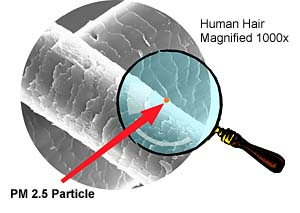 Long term exposure to small particulate pollution from combustion sources, specifically coal-fired power plants, is up to five time more likely to kill you through heart damage than other forms of natural or human-made "PM."
Long term exposure to small particulate pollution from combustion sources, specifically coal-fired power plants, is up to five time more likely to kill you through heart damage than other forms of natural or human-made "PM."
That's the conclusion of new comprehensive study comparing risks from breathing-in the tiniest specs of soot from combustion sources for over 450,000 Americans in 100 cities from 1984 to 2014. Published in the journal Environmental Health Perspectives this month to coincide with the Paris climate talks, the study has ten co-authors and promises to be a milestone in the long fight to reduce this form of pollution.
Combustion of any sort releases fine and ultra-fine particles of soot, or "Particulate Matter" in the often antiseptic regulatory-speak of environmental regulation. These specks differ from dust particles or fireplace soot in that they're much, much smaller and so can be inhaled deeper into the lungs, and then, even pass from the lungs into the blood steam to affect other organs and systems. It's their tiny size that makes PM pollution dangerous on its own. Over the last 30 years, scientists and public health officials have gone from being worried about PM 10 (10 microns or less), to PM 2.5 (2.5 microns or less – about 100th of the width of a human hair), to Ultra-fine Particles.
But soot from combustion also carries residues of whatever was being burned in the facility it came from, and this makes it doubly toxic. If you're burning coal, the soot might carry bits of Mercury, Arsenic, Cadmium and Lead, for example. The new study says that difference is what really drives up risk for people breathing-in coal plant PM.
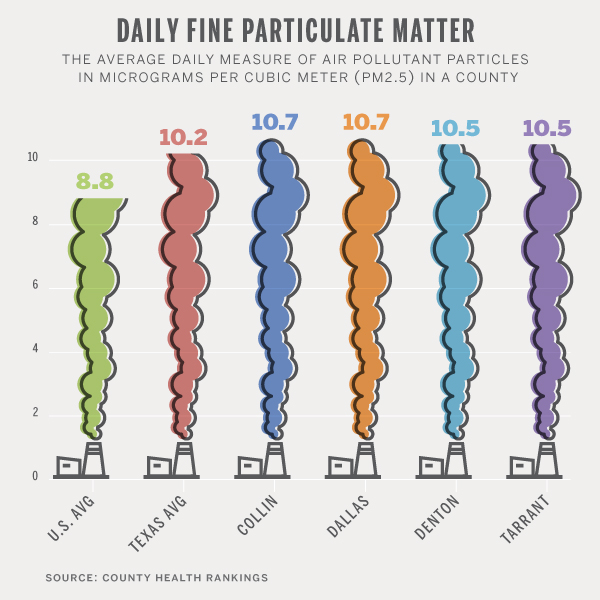
Locally, DFW is chock full of large industrial sources of combustible PM.
We're surrounded by five coal plants in an arc on its northeastern to southeastern side. That means we're downwind of their pollution, including their particulate matter pollution, most of the year. Their impact on local smog levels has recently been chronicled by Downwinders' study from UNT.
PM Pollution would follow approximately the same patterns although heavier particles fall closer to the source, while the really fine particles drift for hundreds or thousands of miles. Luminant’s 2013 Emissions Inventory submission reports 1400 tons of 2.5 particulate matter in a single year at its Big Brown plant. And that may be a severe underestimate. Big Brown’s two Units have exceeded the Texas SIP’s opacity limit of 30 percent on thousands of occasions over the past decade.
Luminant's Martin Creek plant released 2,018 pounds of mercury into the environment in 2013, according to the Toxic Release Inventory, and in fact Texas hosted the top three mercury polluters among all coal plants in the US that year.
Closer in, there's the three Midlothian cement plants with a total of four kilns now. Modernization and controls forced by 20 years of campaigning by Downwinders have brought the numbers down dramatically, but they're still huge facilities that deal in both a dusty raw material, and burning lots of coal and industrial wastes like tires and used oil, and even car parts, to turn that into a higher grade of raw material. When you burn exotic materials with coal, you turbocharge the toxicity of the PM pollution even more. In 2013, the last year the state has numbers posted online, the three cement plants released approximately 440 tons of 2.5 PM pollution.
But cement plants weren't included in the study and so the risk evaluations in it for DFW are underestimated.
Midlothian is also the home to the very large French-owned Amersteel (formally Chaparral Steel) secondary steel mill and steel mills were included as a source category in the study and were also associated with a higher mortality rate. Just about every 18-wheeler trailer you see on local highways loaded with crushed cars is headed to this facility – across the street from the TXI cement plant. Imagine the residues on the soot from melting down thousands of used cars into liquid metal. In 2013, the plant released 133 tons of PM 2.5.
But by far, the largest PM polluter in the DFW area, bar none is the Owens-Corning fibreglass plant in north Waxahahchie, along I-45. It released a whopping 300 tons of PM 2.5 pollution in 2013 alone. No other facility comes close – not the cement plants or the steel mill down 287. Not the GM plant in Arlington. It's not known how much of Owens-Corning PM is combusted however. It could be from the manufactiuring process.
Diesel engines in vehicles were also included, and the study found they has an association with higher mortality, but not nearly as significant as coal plants or steel mills. There's been a steady stream of studies tying highway pollution to respiratory and neurological illness among near-by populations, especially children. Most of the risk is assigned to PM pollution, and most of that is coming from diesels.
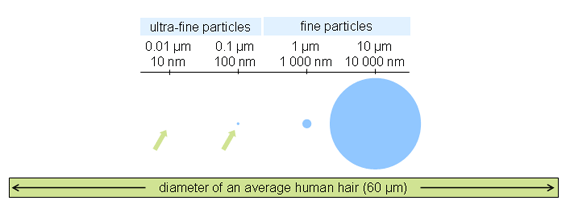
Just as important as the conclusion that coal-combusted particulate matter is significantly more dangerous than your average speck of dust is the study's indictment of current EPA risk assessments that operate on exactly the opposite assumption. The authors are critical that the Agency still weighs the risk of desert dust the same as combusted soot in computing long-term human health effects.
There are potentially enormous public heath and policy implications for North Texans in the study's conclusions.
First, the campaign to get the most modern anti-smog controls included in the latest DFW air plan has the side benefit of reducing PM pollution too. Selective Catalytic Reduction (SCR) on the cement kilns and coal plants decreases smog-forming pollution by up to 90%, and makes an effective additional PM catcher as well, increasing soot capture by 30-50%. The technology is particularly effective on the kind of PM that carries dangerous heavy metals like Mercury. Of course, retiring already-obsolete coal plants would eliminate the threat all together.
Likewise, electrification of compressors would not only lead to decreases in smog-forming emissions, but PM pollution from those sources as well.
Next, it means the already large public health costs of bad air in DFW just published by Dr. Robert Haley of UTSW in his own study are severely underestimated, since they were based on the EPA's own risk assessment software that doesn't weigh the harm of coal power plant PM differently from any other speck of PM 2.5. Adjust those numbers for the exposure to toxic soot and you could see a huge increase in lives lost, illness caused, and dollars spent.
Finally there are implications for almost very other source of combustion around – burning is bad. Where's there's a flame, a boiler, a furnace, a process that means burning something to get something in return, there's going to be PM pollution. What you burn is as important as how you burn it. Burn coal and get the residues of coal on the PM. Burn hazardous waste, and you get the residues from those wastes on the PM. Burn diesel fuel in your truck or car and get residues from that fuel mix packed away in your particulate matter.
As one of the major authors of the study said, if you want to do something about this kind of pollution – start with the most toxic forms of combusted PM. Those mostly come from large industrial sources – the coal plants, cement kilns, and compressors already in our sights because they're also smog polluters. We knew they were a problem. Now we know even more about why they're a bigger problem.
“Help: We Live in Texas.” Our Response to Today’s TCEQ Vote on the DFW Air Plan
(Dallas)— “Help Us: We Live in Texas.”
That’s the plea of a video released today by a local clean air group claiming the state has so intentionally sabotaged Dallas-Fort Worth anti-smog efforts that residents now need EPA to take over the job.
“Texas is as likely to enforce the Clean Air Act in 2015 as Mississippi was to enforce the Voting Rights Act in 1965,” said Downwinders at Risk’s Director Jim Schermbeck, echoing a line in the video.
The group posted the 2:42 minute piece, titled “SOS @EPA” in response to this morning's vote by the Texas Commission on Environmental Quality (TCEQ) to move forward with a new anti-smog plan for DFW that the Commission has already been told by EPA falls short of legal and regulatory requirements.
In the video, footage from a Downwinders’ street action calling for help at EPA Regional Headquarters in downtown Dallas November 5th is spliced with facts about DFW’s 20 years and counting chronic smog problem. Central to the group’s charge is the state’s unwillingness to put new controls on major sources of industrial air pollution like the Midlothian cement kilns, East Texas coal plants, and gas facilities – despite the fact their own air modeling shows those controls could bring smog down enough to comply with the Clean Air Act.
Today’s vote by the TCEQ is the second in 12 months concerning the same DFW air plan. Its goal is to get from an average of 83 parts per billion (ppb) of smog in 2015 down to the current federal standard of 75 ppb by 2017. However, the state only estimates a best-case result of almost 78 ppb. Despite that shortfall, there are no new pollution controls required of any major sources. Over the last 20 years, the state has written five anti-smog plans for DFW. None has accomplished its goal on deadline, and regional smog levels actually rose this year.
Besides once again failing to hit is mark overall, the EPA has already told the State its formal assessment of modern pollution controls for those major sources needed revisiting to be legal. TCEQ refused to comply with EPA and today’s plan contains exactly the same assessment as the one EPA has already said isn’t sufficient, making that part of the plan instantly illegal. Although EPA gives state governments authorization to write smog plans for their own metropolitan areas, it still has final approval based on criteria listed in the Clean Air Act.
One of the points made in the group’s video is that studies by local hospitals have shown DFW childhood asthma rates to be as much as four times the state average and over twice the national average, making the need for cleaner air imperative.
“The health of seven million Dallas-Fort Worth residents is being held hostage by a state government hostile to the goal of clean air. Only federal intervention can save us,” said Schermbeck.
The video can be found at Downwinders at Risk’s website (downwindersatrisk.org), it’s Facebook page, twitter account (@cleaner air) and the group’s YouTube channel (Downwinders’ TV).
__________________________________________________________________________________________
SEND EPA ADMINISTRATORS A MESSAGE TO REJECT THE STATE'S PLAN AND WRITE ONE OF ITS OWN:
https://www.downwindersatrisk.org/featured-citizen-action/
SIGN THE CHANGE.ORG PETITION:
____________________________________________________________________________________
LIKE THIS VIDEO? LIKE OUR WORK? THINK IT'S IMPORTANT?
THEN PLEASE MAKE A TAX-DEDUCTABLE CONTRIBUTION TO DOWNWINDERS BEFORE DECEMBER 31st.
________________________________________________________________________________________
WHY?
It might be hard to believe, but despite being the nation’s fourth largest metropolitan area, and being in constant violation of the Clean Air Act for smog since 1991, and having higher annual smog numbers than Houston, and being singled out by EPA as one of only a handful of areas expecting to STILL be in violation of the Clean Air Act in 2025, there’s still only one professional staff person devoted to cleaning up DFW air: the staff person you pay for when you contribute to Downwinders at Risk.
Besides community organizing on the ground, Downwinders also had to go out and build a new committee of local officials concerned about dirty air after the traditional regional air quality planning process broke down. That committee produced a first-ever study showing how new pollution controls on the kilns, coal plants, and compressors could bring smog levels down enough to comply with the Clean Air Act. Our study was used by the Dallas Commissioners Court to pass a resolution requesting new controls on the East Texas coal plants in October. Had it not been for our new committee, there would have been no local officials involved in the DFW air quality planning process at all, and noaccountability for a state government that isn’t interested in our lungs.
Want to get just basic information about DFW air pollution? There are no dedicated environmental beat reporters left in DFW. Downwinders fills this gap as well, providing the only source of reliable and timely information on DFW air quality issues.
Need technical or organizing training? We do that too. Many of you know we just sponsored our first conference – the four-day Root and Branch Revue, featuring a graduating class of 70 grassroots activists from our first “University of Change.”
When you give to Downwinders, you fund the last line of defense between your lungs and a state government that doesn’t believe smog is that bad for you.
And when you give to Downwinders, you know you’re giving to a group with a two decade proven track record of getting results.
That’s our pitch. We get your donation. You get our best effort at protecting your lungs.
On behalf of myself, and the Downwinders at Risk board, thank you for your consideration.

Jim Schermbeck
Director, Downwinders at Risk
State Re-Submits Illegal DFW Smog Plan, Dares EPA to Reject It

(Dallas)– In an unprecedented rebuke to the Environmental Protection Agency, Texas has refused to provide critical data EPA says it needs to approve the state’s controversial anti-smog plan for DFW, which requires no new pollution controls despite more than two decades of chronic bad air.
Texas' refusal to cooperate with EPA puts its plan, scheduled to be approved by the Texas Commission on Environmental Quality December 9th, on a collision course with the federal agency.
Although EPA gives state governments authorization to write smog plans for their own metropolitan areas, it still has final approval based on criteria listed in the Clean Air Act. EPA disapproval of the State's DFW plan would trigger the possibility of a federal takeover of the air planning process.
That would be fine with local air quality activists, who've been pushing for the EPA to take over the job of writing a new clean air plan for North Texas since the State unveiled its first draft last year. They say TCEQ's official position that smog isn't harming public health means the Commission can't be trusted to write an effective anti-smog plan. When the state announced a plan imposing no new controls on any sources of air pollution despite DFW being in continual violation of the Clean Air Act for the last quarter century, they feel they were proven right.
"It's as if the state is too embarrassed to do what EPA is asking for fear of finding facts that don't match its ideology," said Jim Schermbeck, Director of the local clean air group, Downwinders at Risk.
He noted among the most important missing items in the State’s final plan published November 20th was a "Reasonably Available Control Technology"(RACT) study for the Midlothian cement plants, as well as answers to the impact of controls on other sources like the East Texas coal plants and oil and gas facilities that EPA posed in its eleven pages of official comments on the first draft last February. Application of modern pollution controls to all major sources of air pollution in a smog-plagued region is a key component of the Clean Air Act.
In official comments last February, EPA specifically requested the state perform a new study of what kind of smog controls should be required of the three Midlothian cement plants immediately south of DFW. EPA warned lack of such a study would mean the plan would be disapproved:
"Failure to conduct a thorough RACT analysis for cement kilns which would include appropriate emission limits would prevent us from approving the RACT portion of the attainment plan submittal.”
By turning-in the same version of the technology review originally criticized by EPA, without any new additional analysis, the TCEQ began a bureaucratic game of "Chicken," daring the EPA to deny approval.
"If you're EPA, I don't see how you take this any other way than a big raised middle finger from Austin," said Schermbeck. "The question is: What's EPA gonna do about it now?"
Also missing in the final state version are any responses to other EPA's concerns and questions about the plan's chances of actually lowering smog levels and the possibilities of reducing smog with new controls on other sources, such as,
“How would a reduction in NOx emissions from utility electric generators in the counties closest to the eastern and southern boundaries of the DFW area impact the DFW area?”
EPA was already openly skeptical about the chances of the state’s plan succeeding without requiring any additional cuts in pollution. Stating “it would be difficult to see” how the plan meets its required 2017 deadline, the Agency concluded “we believe it is likely that additional reductions will need to be included to demonstrate attainment.”
TCEQ’s resubmitted plan doesn’t have any additional reductions. Failure of a state plan to show how it can reach the smog standard by 2017 would be cause for EPA to assume the job itself.
Evidence suggests the state is purposely overlooking the air quality benefits of controls on large industrial sources of air pollution affecting DFW.
In late October, Downwinders at Risk released a new study of its own. It paid for University of North Texas engineers to build a clone of the State’s DFW air computer model and run a series of control scenarios the state hasn’t performed in almost a decade. Using the TCEQ’s own numbers it showed new controls on the cement kilns, coal plants, and gas compressors in the Barnett Shale would lower smog levels enough to meet the current federal smog standard. DFW hasn’t met a federal standard for smog since once was created in 1991.
Dismissing the results as “limited,” TCEQ officials nevertheless agreed with them – since they were based on their own model. The State argues those new controls are not yet technically or economically feasible – despite their being commonplace around the world, in the US, and even in Texas.
This question is one of the keys to the standoff with EPA: are the proposed new controls for industry “Reasonably Available” or not? If they are, they must be included in the air plan. If not, they remain off the table. EPA makes the first call on a definition, and any aggrieved party can sue to expand or contract it.
Because it’s a national hot spot for smog, DFW is only one of a handful of US metro areas that even had to submit a clean air plan this last cycle. EPA computer modeling predicts the area will still be in violation of the Clean Air Act in 2015 unless significant reductions in pollution are made.
This summer saw the North Texas regional smog average rise twice in one hot August week, retreating from gains made during last year’s cooler, wetter summer. DFW once again has higher annual smog levels than Houston. Both cities remain well above the current standard.
According to the American Lung Association, the 10 county DFW “non-attainment” area for smog includes approximately 150,000 asthmatic children, 350,000 adults with asthma, and over 600,000 adults with cardiovascular disease or COPD – all of whom are at risk from the region’s bad air.
“The lungs and lives of seven million residents are being held hostage by a state government that doesn’t think smog is a problem and isn’t willing to require new pollution controls to reduce it, “ Schermbeck pleaded
“Expecting the State of Texas to enforce Environmental laws in 2015 is like expecting the State of Mississippi to enforce Civil Rights laws in 1965. Our only hope is federal intervention.”
TCEQ: New Smog Numbers Widen Clean Air Gap, But Still “Close Enough”
 Only an hour after a public plea to EPA by local residents to rescue them from the state's laissez-faire enforcement of environmental laws, the Texas Commission on Environmental Quality proved the protesters' point at last Friday's regional air quality meeting by announcing a bigger gap between the current federal smog standard and the Commission's anti-smog plan supposedly designed to meet that standard in DFW.
Only an hour after a public plea to EPA by local residents to rescue them from the state's laissez-faire enforcement of environmental laws, the Texas Commission on Environmental Quality proved the protesters' point at last Friday's regional air quality meeting by announcing a bigger gap between the current federal smog standard and the Commission's anti-smog plan supposedly designed to meet that standard in DFW.
The goal is to average 75 parts per billion (ppb) or less of ozone in the air over any single eight hour period at all 20 DFW monitors by 2017, per a court order that rolled the deadline back from 2018. DFW is at 83 ppb now. TCEQ announced its latest estimates have DFW clocking-in a best case scenario of 77.8 parts per billion by the end of 2017.
But don't worry, because TCEQ says that's still "close enough" to 75 to count as a bulls-eye.
One wonders what would happen if this kind of precision was practiced in other critical fields. Your surgeon mistakes your Thoracic Aorta for the Abdominal Aorta? Understandable, they both start with "A." Bank statement off by a decimal point or two? Surely not enough of a change to worry about.
And is a jump of almost two parts per billion in regional smog over the last estimate any reason for perhaps considering new smog controls for major sources of pollution, like, say, cement plants, coal plants, or oil and gas sources? Nope, says TCEQ. No need to inconvenience those industries because of some little ol' public health harms that we as a state agency have been trying to downplay and deny for years now.
"2 to 3 parts per billion here, 2 to 3 parts per billion there – what's the difference" TCEQ asks? "We'll throw in things the EPA can't possibly quantify – like 'sustainable building' and 'bicycle paths' and Viola! we'll get down to "77" ppb in two years with no problems…somehow. That's within the margin of error – that we always blow past. We've always relied on this tried and true approach of aiming low and we've had great success so far, we're 0 for 5 in reaching attainment on time over the last two decades."
Co-facilitating this charade to some extent is EPA itself, which still allows state governments to round DOWN 77.8 to 77, knocking off almost a whole part per billion in TCEQ's always-sunny scenario on paper, if not in the actual atmosphere of 2018, where it counts more.
Particularly galling about the state's lackadaisical approach to meeting the current 75 standard is that it comes at a time when we know that number is still too high to adequately protect public health. EPA has just proposed lowering it to 70 ppb based on an overwhelming amount of evidence. Instead of a smog plan that always seems to come in two to three parts per billion over the standard, how about we draft one that comes in at one to three parts per billion under the standard? One that anticipates the need to get even cleaner air in the future and gives us a running start?
As it turns out, we have fresh evidence, provided by the state's own computer model, that requiring off-the-shelf modern pollution controls on those cement kilns, coal plants, and oil and gas facilities could lower DFW regional smog by at least one to two parts per billion, putting us in a much more likely position to actually meet the smog standard. TCEQ looks at this result, wrinkles up its collective nose and says its only a one or two parts per billion change. To which the logical reply is: "OK, show us how you get down closer to 75 ppb without cuts in emissions from those major sources."
Crickets.
Because of course, TCEQ has no alternative, no Plan B, no way to get down to the 75 ppb standard that involves doing something. It isn't invested in that goal. As its website explains, the Commission's "customers" are the industries seeking its permits. Many of those customers are very upset at the mean ol' EPA for following the Clean Air Act. And the customer is always right.
So TCEQ drafts a customer-friendly clean air plan for DFW with no controls on any major sources, makes a new federal gasoline mix do most of the work in the computer model, and (theoretically) crosses the finish line at three parts per billion over the standard. See how hard they tried?
The last time TCEQ tried as hard was the 2011 DFW clean air plan. That "do-nothing" plan was predicted by the state to take us to historically low smog levels because so many more new cars were going to be purchased – during the Great Recession. All we had to do was sit back and watch those babies fly off the lots!
It was the first DFW clean air plan in 20 years to actually produce higher smog levels.
First, but maybe not the last. Regional smog averages rose twice this summer – the first of three that make up a running annual average determining success or failure of the TCEQ plan by 2017. How do you know when a TCEQ clean air plan is being implemented? Smog goes up.
EPA's own modeling is already predicting TCEQ's current "do-nothing" plan won't work, and concludes DFW will be one of only a hand full of metropolitan areas still breathing unsafe and illegal air ten years from now.
In point of fact, no matter how many parts per billion, no gap would be wide enough for TCEQ to find cause for more pollution controls on major sources. They've rigged the game to produce a result they hope allows them to slide by and get EPA approval. It's our responsibility to make sure EPA doesn't give it.
Texas state government has no intention of trying to meet the federal smog standard. It has every intention of dragging out the process so it's unwillingness to implement measures to meet it are obscured by more deadline failures and new Designed-to-Fail plans from Austin. It is a never-ending cycle there's no escape from as long as TCEQ is in charge. Expecting Texas to vigorously enforce environmental laws in 2015 is like expecting Mississippi to enforce federal civil rights law in 1965.
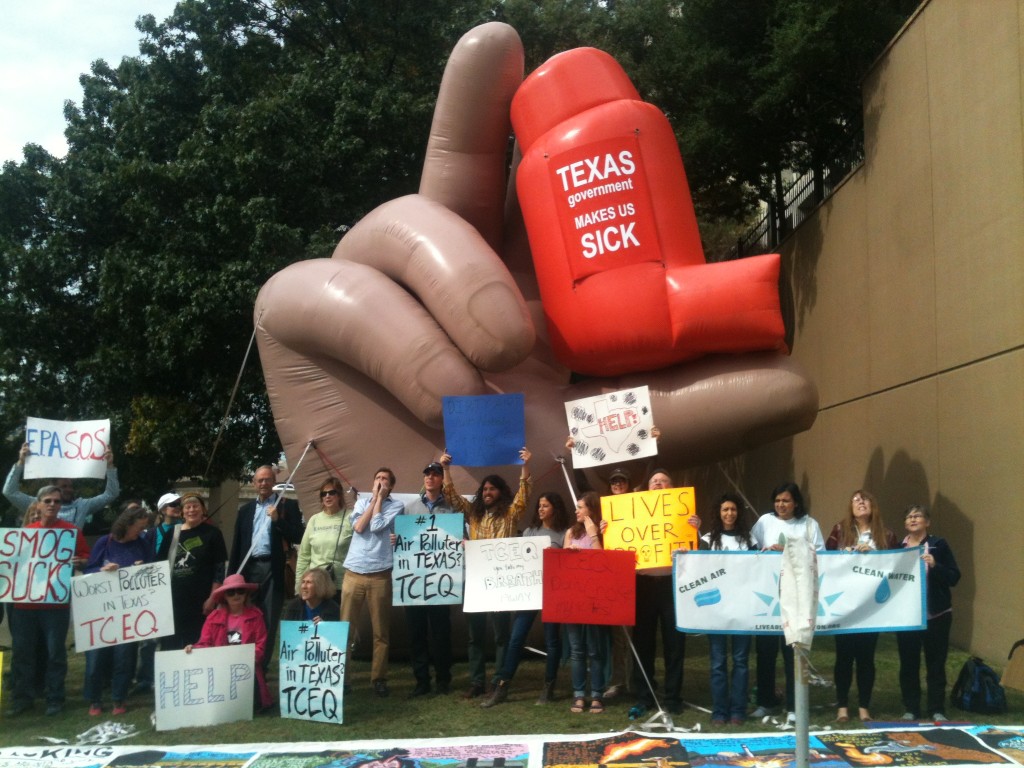
That's why it's important for EPA to takeover the job.
Is it a perfect solution? No, but it's one with a beginning, middle and end, carried out by an agency that still officially believes smog is a public health threat.
PLEASE…sign the petition for a real clean air plan from EPA
AND
Only we can prevent another twenty years of dirty air.
Root and Branch Post Mortem: Qualified Success
 Your view of Downwinders' first Branch and Root Revue grassroots conference depends very much on which event you went to and what you were expecting. For the most part however, participants seemed to agree that for a first time effort it was a valuable addition to the annual activist calendar.
Your view of Downwinders' first Branch and Root Revue grassroots conference depends very much on which event you went to and what you were expecting. For the most part however, participants seemed to agree that for a first time effort it was a valuable addition to the annual activist calendar.
Beginning Wednesday night the 4th, we sponsored the November show of Bar Politics featuring an evening of satire targeting local environmental scandals and screw-ups. A full crowd showed up at the Rustic to see Josh Kumler and Company hit one out of the…bar. Smog and the woefully misnamed Texas Commission on Environmental Quality were targets. So was the City of Dallas and it's attempts to "civilize" the Trinity river bottom into more productive uses like an equestrian center and golf course.
Amidst tornado warnings, we hosted a brainstorming session at the Texas Theater on Thursday evening that began a discussion on the "Future of Fighting Fracking in Texas." Although not as well attended as we hoped, the momentum from this first session led into Saturday's SRO Part 2, and what emerged was several new, more coordinated strategies that look like they might have a future. If you want more information about these brainstorming sessions and what they produced, please get in touch with Tamera Bounds of Mansfield Gas Well Awareness.
With the announcement that the Keystone pipeline was dead, Friday the 6th was a good day to be an environmentalist. An energetic group of 30-40 DFW residents celebrated by setting-up shop across the street from EPA Regional headquarters in Dallas and constructing a huge block-letter "S.O.S." on Munger street, along with a gigantic inflatable inhaler with the message: "HELP! We live in Texas." EPA employees got the message that we need them to take over enforcement of federal environmental laws instead of letting a state government that doesn't even believe smog is a problem delay, block and challenge needed reforms.
Without a doubt the most well-attended and popular event of the entire conference was our one-day "University of Change" on Saturday at First Unitarian Church. Between 60 and 70 activists were split into two tracks of nine workshops, including "How to Get Better Media Coverage," "How to Do Your Own Environmental Sampling," and "The Basics of Fighting Permits in Texas." Whatever second thoughts organizers might have at the beginning of the week were quickly dispelled by the high level of energy produced by these workshops – and carried over into a two-hour post-conference social gathering at the near-by Five Creeks Tavern.
In large part the success of this year's inaugural Root and Branch can be traced directly to the featured guests – Lois Gibbs and her husband Stephen Lester. It's hard to imagine any other living environmental legend being a better fit with the personality of Downwinders at Risk, AND having the spectrum of skills and resources in demand by local activists. Down-to-earth, direct, approachable, empathetic, incredibly helpful – the couple was described by participants as all of these things during their stay.
One of the most satisfying outcomes was being able to acquaint or re-acquaint people with Lois' incredible personal and professional story. Workshop participants not born when Love Canal was making national headlines learned why it's a milestone event. Those of us already in the know were grateful for so much face time with someone who's been described as "the Rosa Parks of the environmental movement."
Despite constant badgering, media coverage was at best sketchy, and at worst, non-existent. This was especially disappointing to see from publications who one would think would be more citizen-friendly, including the Dallas and Texas Observers. Even the Star-Telegram ran a preview piece. Only the reliable Fort Worth Weekly came through in the way you'd think an "alt media source" would.
Thanks to all who came to one or more events. Thanks to all of our sponsors and donors. A round of cheers for the Downwinders at Risk board, who took a leap of faith and landed on their feet. We're already mulling the lessons learned and looking toward Root and Branch 2016. After the holidays, we'll be looking for help to put together next year's festivities. Let us know if you're interested.
Weren’t There? Watch Last Night’s “Get Polluted with Bar Politics” Anyway
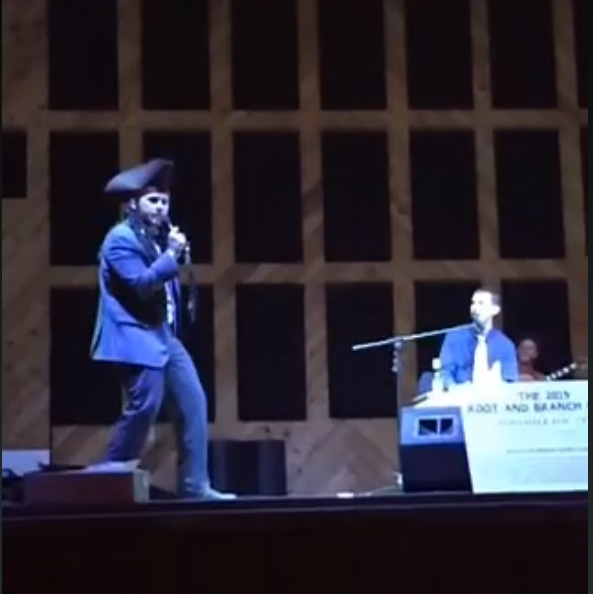 Here's the link. Consensus is that it was one of their better efforts.
Here's the link. Consensus is that it was one of their better efforts.

